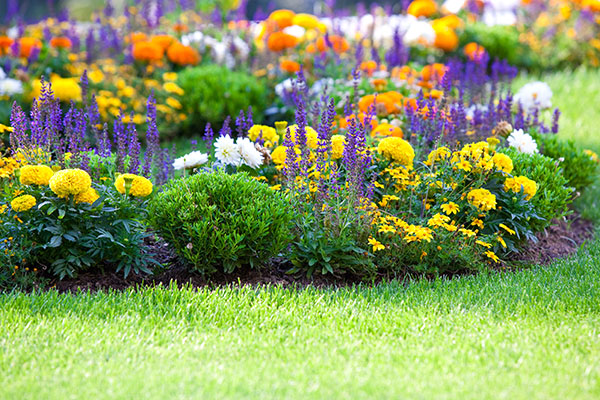When you’re trying to make sure your landscape is as beautiful and striking as possible, one of the best elements you can add is a garden or flowerbed. These spaces truly shine as the gems of your yard, adding flairs of color and showing how carefully you maintain your space.
At J&S Lawn and Landscape LLC, we don’t think anyone should go without a gorgeous garden. If you’re looking to make a visual impact, all it takes is learning how to take care of the garden you’ve planted.
It’s not as hard as it sounds. Here are our six best tips for keeping your garden looking vibrant and fresh all season long.
Proper Plants
For many people, gardens are a way to bring exotic plants and flowers to live in an environment that they aren’t meant for. While this can make a striking garden, especially when it’s first planted, choosing plants that aren’t indigenous to your environment can make any garden difficult to maintain.
Plants fare much better in conditions that they’re naturally suited for, so if you’re looking to keep the maintenance of your garden to a minimum, choose plants that like your environment. Search a little to find flowers and plants native to your area, and you’ll find that it’s much easier to keep a healthy and blooming garden or flowerbed.
Mulch
Many gardens end up overrun with weeds and unwanted plants as the summer progresses. There isn’t much you can do to stop the growth of weeds, but if you take preventative measures, you can limit their spread.
Mulching your gardens is one of the best ways to stay on top of your weeds, keeping your plants as the main feature of your gardens. Mulch not only looks fantastic, but it lasts all year without needing any upkeep. But more than just how it looks, mulch also offers a few maintenance benefits. As it slowly decomposes, it can be a fertilizer for your plants. Most importantly, it blocks the sunlight that weeds need down low to grow. This can save you time and energy on your weeding efforts.
Weeding
Even if you have used mulch in your gardens, weeds can become an issue. Many gardens develop weeds over time, but this doesn’t mean you can’t prevent their spread. If you’re looking to keep your gardens weed-free for the summer, it’s always best to attack them early.
In the early spring, weeds are just starting to take root and may seem small; however, if you remove them at this stage, you will find that weeds never grow as tall or as strong all year long. Weeds need time to dig strong roots and grow tall, and that requires a head start in the springtime. If you can be proactive, you can limit their spread throughout the summer.
Work more efficiently by focusing on weeding early in the year, preventing growth throughout the summer.
Watering
It may seem like a no-brainer to water your garden, but the truth is that it’s not as simple as you might think. There are better ways to water your garden that can limit the amount of water and time it takes to do so.
When you’re watering your garden, you need to make sure the water is getting to the roots at the best time. This means always watering deeply, not on top of the plants but down at the base. It’s also best to water in the morning when the sunlight isn’t strong enough to evaporate the water away.
You want as much water to penetrate deep into the soil as possible. In the dry spells of summer, plants need about 1 inch of water per week, so make sure you frequently water to help them thrive.
Plant Pruning
As plants grow, they may need some attention to remain strong and healthy. Plant pruning is a step that not many garden owners take because they are worried about damaging their plants. While it’s true that you have to be careful, pruning is an essential step for a healthy garden.
Some tips for doing it properly include:
- Prune after a plant has flowered, so your plant has the energy to repair itself.
- Don’t leave stubs behind, as they will not cover over and can be entry points for fungus and disease.
- Cut a dead branch only back to the next bud. This will help ensure the branch can continue to grow and live in the future.
Pruning can be a scary task, but with these tips, you should be able to keep your garden from becoming unhealthy and overrun.
Fertilization and Compost
All plants need fertilization and nutrients to grow, and this is no different for the flowers in your flowerbeds. There are many types of fertilizers you can buy, and even some you don’t have to buy.
There are different practices for fertilizing different types of plants, but for new flowerbeds, you generally want to work fertilizer through the top 4 to 6 inches of soil before you plant. After that, you can spread it evenly around plants and rake it through the soil.
Compost and organic matter are eco-friendly options for fertilization, but only if used when completely decomposed. You’ll notice how bright your garden becomes with a little extra nutrition, so don’t hesitate to add fertilizer!
Conclusion
Gardens can be challenging to maintain, but if you use the tips we’ve given you, you’ll find it much easier. Let us know in the comments how you manage your gardens!
And if you’d rather pass the effort of caring for your gardens off to a professional instead, don’t hesitate to get in touch with us. At J&S Lawn and Landscape LLC, we can do all the watering, weeding, and fertilizing, so you don’t have to.

